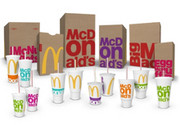 |
| Reviews and Templates for Expression We |
6 Sustainable Packaging Trends to Watch in 2016

McDonald’s rolled out its new packaging this month along with a pledge to source 100 percent of all fiber-based packaging from recycled or certified sources by 2020.
This follows the fast-food chain’s November announcement that its centrally purchased packaging in Europe is 100 percent sustainably sourced. This includes cartons, cups, bags, napkins and tray liners, all made with wood fiber from recycled sources or forests certified by the Forest Stewardship Council or the Programme for Endorsement of Forest Certification.
A month after COP21, with the climate deal and its ambitious emissions cuts still at the forefront of businesses’ — and consumers’ — minds, Environmental Leader discussed sustainable packaging trends with the experts. Here’s what they expect to see in the year ahead.
1. Shrinking Carbon Footprints
Sustainable Packaging Coalition senior manager Adam Gendell says he expects the industry to look to reduce its carbon footprint in 2016. “The recent COP21 event underscored the longstanding scrutiny on greenhouse gas emissions from the manufacturing industry, and we saw a number of influential companies double down on their commitments to reduce their emissions,” Gendell says. “Especially since reductions in carbon footprints tend to accompany reductions in other environmental indicators, it makes sense for industry to focus their efforts on carbon.”
2. 100 Percent Bio-Based PET
Coca-Cola has been producing partially bio-based PlantBottle since 2009, but the commercial production of 100 percent bio-based PlantBottle still remains elusive. “The realization of 100 percent bio-based PlantBottle hinges on the successful development of a route towards biobased terepthalic acid (bio-TPA) or its equivalent,” says Lux Research’s Meraldo Antonio, a research associate on the firm’s bio-based materials and chemicals team. “To this end, Coca-Cola is engaging three technology developers: Gevo, Virent and Avantium.”
In June 2015, Coca-Cola and Virent announced that they had produced the world’s first 100 percent bio-based PlantBottle — at demonstration scale. “As Coca-Cola and its partners continue to put heavy emphasis on the commercial realization of 100 percent bio-based PlantBottle, we expect that in 2016, similar announcements of scale-up milestones from Coca-Cola’s three technology partners will emerge,” Antonio says.
3. Downstream Supply Chain Players Measuring Upstream Suppliers
“Procurement guidelines are becoming more sophisticated with sustainability metrics, companies are requesting more audits, more measurements, and a broader understanding of supply chain performance,” Gendell says. “So far, most of this activity has been measuring for the sake of measuring, but it’s only a matter of time before it’s commonplace for meaningful business decisions to be made based on the environmental preferability of upstream operations. 2016 could be that year.”
4. Novel Bioplastics
Antonio says Lux Research expects technology developers this year will improve the mechanical, thermal, and barrier properties of bioplastics. “In the past, problems concerning these properties were the bane of bioplastics and served as a roadblock for adoption in products that require heat-based sterilization or pre-serving heating,” he says. “However, continued innovation has allowed some companies to launch bio-based packaging that meet these requirements.”
For example Toray, a Tokyo-based manufacturer of fibers and textiles, plastic resins, films and carbon fiber composites, has introduced new lidding films (called LumiLid) that Antonio says include greater than 50 percent renewable feedstocks content and can withstand temperatures of up to 400 degrees Fahrenheit. “We expect that in 2016, more of these higher performance sustainable packaging material will be introduced.”
5. Waste Reduction
“Zero waste” was the 2015 catchphrase, according to Gendell, who says waste reduction will continue to be a sustainable packaging trend in 2016 and beyond. “We know that companies always want recyclable packaging,” he says. “It’s good for business. Consumers understand it, and it can keep industry in the good graces of regulatory agencies.” But, Gendell says, there aren’t a lot of corporate sustainability goals that focus on increasing recycling compared to, say, decreasing carbon footprints. “We very well may see the industry conversation pivot from recyclability to a different mechanism of waste reduction,” he says. “But since waste reduction so often relates to cost reduction, we can feel confident that it won’t fade from the spotlight any time soon.”
6. Edible Packaging
We’ve already seen this concept grab headlines last year, with PepsiCo reportedly considering edible packaging and WikiCells, a startup founded by Harvard professor David Edwards, developed self-contained edible packaging in an effort to reduce plastic and paper waste. “Although such cradle-to-cradle approach to eliminating waste created from food packaging is certainly interesting and headline-worthy, its implementation is confronted with many challenges, including logistical (i.e. the risk of this packaging material being broken up) and marketing challenges (i.e. consumer’s impression that such packaging is unhygienic),” Antonio says. “We believe that in 2016, such novel concept will continue to attract media attention, although mass commercialization is still distant.”
|
|
|
|
Copyright 2011 Energy and Technical Services Ltd. All Rights Reserved. Energyts.com |